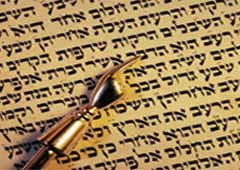Nitzavim-Vayelekh: The Last Mitzvah

Deuteronomy 29:9 – 31:30
A well-known talmudic tradition reports that there are exactly 613 mitzvot (commandments) in the Torah. Of the total, 248 are positive (the do's), while 365 are negative (the don'ts). Not all the sages are in complete agreement on this enumeration, with some arriving at a higher number. But the custom has long been to speak of 613 mitzvot—or, in Hebrew, taryag mitzvot, based on the numeric values assigned to letters of the Hebrew alphabet.
Two foremost medieval enumerators of the mitzvot were Maimonides (1135-1204) and his philosophical arch-adversary, Nahmanides (1194-1270). Following the Maimonidean system, an anonymous work compiled by a father for his son in late-13th-century Spain became one of the most popular collections of the age. Titled the Book of Initiation (Sefer Hahinukh), the book distributes the 613 items on Maimonides' list among the weekly portions of the annual Torah cycle, enabling the reader to study each mitzvah in place, as it were.
And that brings us to this week's portion, which according to Sefer Hahinukh is the locus of the final, 613th, mitzvah: "A mitzvah upon each and every Israelite to write his own Torah scroll." As its authority, the Sefer Hahinukh cites a passage in the Talmud (Menahot 30a): "Whoever handwrites a Torah scroll is regarded by Scripture as though he had received it at Sinai." The connection with this week's reading lies in the references by Moses to his own faithful recording of God's teachings in the scroll of the Torah and his injunction to the priests and Levites that those teachings be periodically read aloud to all the people—men, women, children, and strangers in the community—"that they may hear and learn to revere the Lord your God and to observe faithfully every word of this Torah."
But why is each individual Jew mandated to possess a private copy of the Torah—and preferably one written in his own hand? The general purpose behind the mitzvah is to make the text readily accessible for purposes of study and religious observance. The successful performance of this mitzvah is considered to be a favorable omen for the religious accomplishment of the writer and of his descendants.
The reference to descendants raises another question, however. If a previous generation has met its obligation of writing Torah scrolls, why should a subsequent generation be required to produce its own when there are already sufficient numbers in circulation? The point did not escape the attention of the author of Sefer Hahinukh. His answer: writing a new scroll "enables each and every Jew to read out of a new book, lest they be disgusted with reading the old books bequeathed them by their ancestors."
This insight translates well into our contemporary idiom of electronic media and computerized databases. In an age when textbooks are published anew each year, and Wikipedia articles undergo editing and revision at an hourly pace, how can we ensure that our descendants will not find our current Torah texts aesthetically alien and displeasing? Clearly, if present-day taste runs to e-books and portable reading devices, then that is where Torah must go as well. If contemporary readers prefer to obtain their Jewish inspiration from web-based sources, then there, too, is where Torah must be.
In fact, isn't that where we are right now?
Moshe Sokolow, professor of Jewish education at the Azrieli Graduate School of Yeshiva University, is the author of Studies in the Weekly Parashah Based on the Lessons of Nehama Leibowitz (2008).
Comments are closed for this article.




